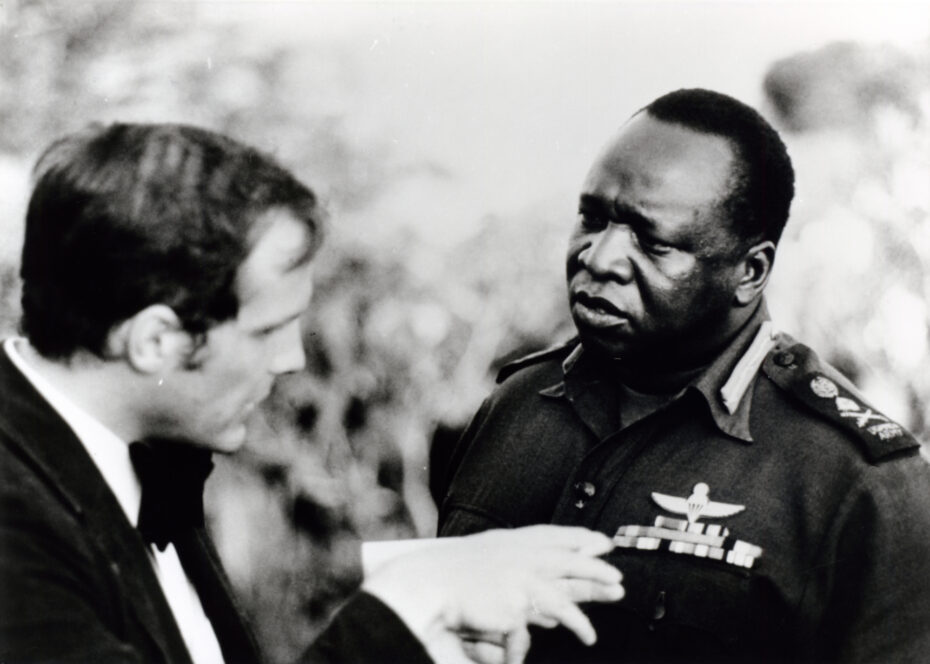“Selling the Brooklyn Bridge again, huh?”Every Day's a Holiday (A. Edward Sutherland, 1937)
Nov
21
National Entrepreneurs Day

Lobbycard. Peaches O'Day (Mae West, dressed by Schiaparelli) hands her business card to yet another sucker. They're on the Brooklyn Bridge, which can be seen in the background. DP: Karl Struss.
The main character is an entrepreneur: National Entrepreneur's Day (USA)
In my book, entrepreneur is just a fancy talk for conman. A famous one, the one who may've tried to sell you the Brooklyn Bridge, was George C. Parker. He'd peddle the famous landmark to any hapless rube, immigrant, or sucker who then would promptly erect a little tollbooth to make a fast buck from any hapless rube, immigrant, or sucker.
– Police captain Jim McCarey
Like Parker, Mae West's Peaches O'Day bamboozles it her way. And boy, does she have a bridge to sell you!
politics
“I done wrestled with an alligator, I done tussled with a whale; Handcuffed lightning, thrown thunder in jail; Only last week, I murdered a rock, injured a stone, hospitalized a brick; I’m so mean I make medicine sick.”Muhammad Ali, the Greatest [Float Like a Butterfly, Sting Like a Bee] (William Klein, 1974)
Sep
4
Mouthguard Day

A randomly picked screenshot showing Muhammad Ali fighting George Foreman. Each and every scene of a William Klein film is a photograph. DPs: Étienne Becker, William Klein, Richard Suzuki & Patrice Wyers.
– Muhammad Ali
“À bas le colonialisme ! À bas l'imperialisme !”Festival panafricain d'Alger [The Panafrican Festival in Algiers] (William Klein, 1969)
Jul
26
One Voice Day

Black hands holding each other. In translation the caption reads “Down with colonialism! Down with imperialism!”. DP: William Klein et al.
In typical Western fashion the credits for William Klein's Festival panafricain d'Alger focusses on the French and American participants. After Algeria regained its independence in 1962, it became Africa's – and the #AfricanDiaspora's – centre for postcolonial and liberation moments.
The 12-day Festival panafricain attracted 5000 people from all over the African continent, as well as liberation fighters from the United States.
O Bandido da Luz Vermelha [The Red Light Bandit] (Rogério Sganzerla, 1968)
Jul
1
prairie oyster

The bandit (Paulo Villaça) cracks a raw egg over his liquid breakfast while one of his female victims (Sonia Braga) is on the phone beside him. Her cigarette smokes itself and the kitchen table is packed with drugstore items. DPs: Peter Overbeck & Carlos Ebert.
“You film. Film helicopter.” Général Idi Amin Dada: Autoportrait [General Idi Amin Dada: A Self Portrait / No One Can Run Faster Than a Rifle Bullet] (Barbet Schroeder, 1974)
Jun
9
National Heroes Day Of Uganda

Schroeder in tuxedo interviewing General Idi Amin Dada Oumee. Even in the context of the scene, Schroeder just came from a gala event, the tuxedo is a statement of assumed superiority. DP: Néstor Almendros.
It's easy… no lazy to put this documentary away as a failed Idi Amin propaganda project. In 1974, German-Swiss Barbet Schroeder, privileged son of a diplomat, already knew more than enough about how to select framing and manipulate timing. The result, Général Idi Amin Dada: Autoportrait, is a prime example of the neo-colonialist gaze.
– The General explaining a director's one and only task
Amin, clearly not speaking his native language, tries to explain his plans for #Uganda. The camera (Spanish cinematographer) moves in on his gesturing hands, then a jump cut (French editor) to soldiers who – instructed in English – seem unsure of what is asked of them. When (in the copy I watched) people speak in Swahili, no translation is provided and the portrayed are little more than undeveloped, exotic backdrop. Everything seems to be a joke to Schroeder: the air force's MiGs, Amin and his higher-ups joining tribesmen in dance, even the President's children are used to exemplify the stereotype of the overly virile, primitive African male.
Amin was, as Schroeder is, a product of Europe's Scramble. With the difference that, although bloody and despicable, Amin's strategy was not to embolden the West's moribund empire.
“Convert all Parisian universities into reception centres for the revolutionary youth of the whole world.”Grands soirs & petits matins [May Days] (William Klein, 1978)
Jun
6
National Higher Education Day

Students discussing at the Sorbonne. DPs: William Klein & Bernard Lutic.
A ripple went through France in the early months of 1968. It started when the Communist and socialist party joined forces in an attempt to remove President De Gaulle from office. A month later, students at Nanterre (a Parisian university) teamed up with poets, musicians and small leftist groups to discuss class discrimination and political bureaucracy on campus. The meeting was peacefully disassembled but tensions remained. In May, Sorbonne students stood up for Nanterre, by then shut down. Then, police invaded the university and 20 000 stood up against the police.
– student proposal
Somewhere in that crowd were those whose interest went beyond the main spectacle: the toppling of the new ancien regime. A #JeanRouchian anthropologist of sorts, artist, photographer and filmmaker William Klein pushes the eye through the masses. But it's also his eye; each frame is a Klein. However, we see not a documentary. Sound is asynchronous. Suddenly, it's night and flames lick the black sky. When bricks fly, frames follow. And then… the end.
“cut”Cuadecuc, vampir (Pere Portabella, 1971)
May
26
World Dracula Day

Lucy (Soledad Miranda) in bloody embrace with Dracula (Christopher Lee). DP: Manel Esteban.
A black forest. A man walks through, holding a smoke machine. Then a carriage with a familiar coachman. Dracula! Where are we? No, not 19th century #Transylvania. The film stock reveals bullet holes in ancient walls, and beyond these walls a ladder, maybe scaffolding. A pneumatic drill, more crew members, lights, a clapperboard. Are the characters aware of that? Them seem to interact with the disturbance yet oblige to the interruptions of the movie set. In a state of hypnopompia, guided by kuroko, maybe?
Pere Portabella created a hyper-reality with his Cuadecuc, vampir. A director dismantles the man-behind-the-curtain, Franco, the other #Franco while setting up scaffolding for the next Spain. Everything's a reality, or an illusion, then nothing is.
Peace, little girl (1964)

March 21: #countdown to #NationalCountdownDay
Peace, little girl [Daisy aka Daisy Girl] (Sidney Myers, 1964)
One… two… three… four… five… seven… six… six… eight… nine… nine…
It was the #PoliticalAd campaign to end all political ad campaigns. Peace, little girl opens innocently enough with a little blonde girl, picking the petals of an ox-eye #daisy while counting. When the final petal's gone, the tone changes completely.
This deceptively simple propaganda film was made in support of Lyndon B. Johnson's 1964 presidential campaign by ad agency #DBB and media consultant Tony Schwartz. It was so effective and bleak in is insinuations that the Johnson campaign was forced to pull it after only one screening.
What fascinates me is the similarity with one particular scene from James Whale's #Frankenstein (1931). The Monster (#Karloff) meets a little girl who sits on the shore of a lake, picking daisies. He approaches her, and the girl, knowing the creature is a good man at heart, invites him to play a game with her involving them tossing the daisies into the lake.
The Monster (Boris Karloff) and little Maria (Marilyn Harris) playing with daisies on a beautiful day at the lake. DPs: Arthur Edeson & Paul Ivano.
Spoiler warning
When they run out of daisies, the Monster picks up the girl who to him is as pretty and innocent as a flower, and tosses her into the water.This scene was cut and considered lost until the 1980s. Could Tony Schwartz have been aware of that scene? He was at the right age to have seen the pre-code, pre-cut version.
#Bales2023FilmChallenge #SidneyMyers #LyndonBJohnson #ChrisSchenkel #MoniqueCorzilius #MoniqueCozy #RobertDryden #DrummondDrury #ShortFilm #war #peace #scaresploitation #flowers #propaganda #ColdWar #election #politics #USA #1960s ★★★★☆
“If she is innocent! Why do you never wonder if Parris be innocent, or Abigail? Is the accuser always holy now? Were they born this morning as clean as God's fingers? I'll tell you what's walking Salem — vengeance is walking Salem. We are what we always were in Salem, but now the little crazy children are jangling the keys of the kingdom, and common vengeance writes the law!”Les sorcières de Salem [The Witches of Salem / The Crucible] (Raymond Rouleau, 1957)
Mar
7
National Town Meeting Day

The townspeople meet in the barn to judge the accused. DP: Claude Renoir.
Raymond Rouleau's Les sorcières de Salem – with a screenplay by Marxist philosopher Jean-Paul #Sartre – is a very early film adaptation of Arthur Miller's 1953 #TheatrePlay The Crucible. An allegory of #McCarthyism, the play is a (partially dramatised) retelling of the #SalemWitchTrials, a dramatic episode in early US-American history. During several court and town meetings, 200 people were falsely accused of meddling with the Devil; 19 of them were eventually executed.
– Arthur Miller, The Crucible (1953)
Miller himself was accused of un-American activities in 1956 and convicted of contempt of Congress for refusing to identify others present at meetings he had attended. Which doesn't mean that #WitchTrials are a thing of the past. As easily one can transplant Puritan religious mass hysteria to 1950s McCarthy anti-socialism, as easy is it applicable to the state of the world today.
“Aaaaap”
“Nooot”
“Miiieees”Het Leesplankje [The Reading Lesson] (Johan van der Keuken, 1973)
Mar
2
National Read Across America Day

Reading board tiles laid out on a newspaper. Half a headline – 7.000 ARRESTANTEN (“7000 DETAINEES”) – can be read. A photograph of a shellshocked, very young soldier in front of a fleeing crowd illustrates the article. DP: Johan van der Keuken.
Amsterdam schoolchildren recite the words from a reading board while the traditional teaching method's pictures are interspersed with news photos of then-current events and children's drawings.
This short, and life, is haunting and violent; schools should be safe for all. Even if only to escape in a book.
